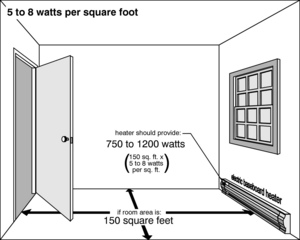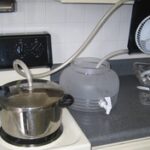Electric baseboard heaters first became popular in the ’70s when the oil criss hit. This type of heat carried with it some different principles with it that water and steam baseboards didn’t carry and there were some unfortunate fires due to electric baseboard heaters. Today these heaters are used sporadically around homes across the United States that have had additions or remodeling projects performed where adding ductwork and upgrading existing HVAC systems was simply too expensive. Because of this, electric baseboard heat can be a good option for your home.
Size Of Baseboard Heater
The size of the baseboard depends entirely on the size of the room. The general rule of thumb has always been 5-8 watts per square foot. So if you have a 12’x12′ room, you have 144 square feet. This means you would need somewhere at or between a 720-1,152 watt electric baseboard heater. A good in between would be 1,000 watts.
Wire and Fuse Size
Electric baseboard heaters require a 20 amp breaker in order to function because the load is a constant draw of electricity. The amount of electricity used is the same at startup as it is in the middle of heating. The wire size should be no less than 14 gauge (typical of 15 amp circuits) but it is recommended that 12 gauge be used. It is also a good practice to use conduit to house the wires because of possible fire hazards. This may be a code requirement in your jurisdiction anyway but is not required in all jurisdictions.
Proper Clearances
Electric baseboard heat gets very hot and can burn furniture, drapes, any other objects that are combustible around it very quickly. Drapes should be either 8 inches about the baseboard or 3 inches in front with 1 inch of clearance to the floor. This allows the hot air to escape and will prevent fire.
Be careful of children’s toys as many are made of plastic and tend to melt and start on fire very quickly if left new an electric baseboard heater.
Make sure you have at least 3 inches of space behind couches or chairs that are on the same wall as an electric baseboard heater. The couch should also have legs at least 1 inch off the floor to allow for air exchange and prevent fires.
Outlet Locations
When planning to install a baseboard heater, be mindful of where the outlets are in a room. Try to keep your electric baseboard heaters in between the outlets. This will prevent someone from plugging in an appliance and the cord draping over the baseboard and causing a fire hazard.
Best Location
The best location for baseboard heaters from a comfort perspective, is below windows. This seems to cut down on the feeling of the convective loop. Baseboard heaters should always be installed on the floor. Ceiling unit, if used, should be equipped with an auxiliary fan to blow the heat off the ceiling.
Where To Use Electric Baseboard Heaters
You can use electric baseboard heat in virtually any room. Each unit comes with it’s own thermostat and control. Keep in mind that this type of heat is significantly more than natural gas and should be used with energy consumption and efficiency in mind. But, when you have a small addition or the inability to run ductwork, electric baseboard heater s are a great solution and will heat any space well.
Using electric baseboard heat can be a great option for your home in the right places. Follow general safety precautions and you will have years of trouble free, comfortable heat.



